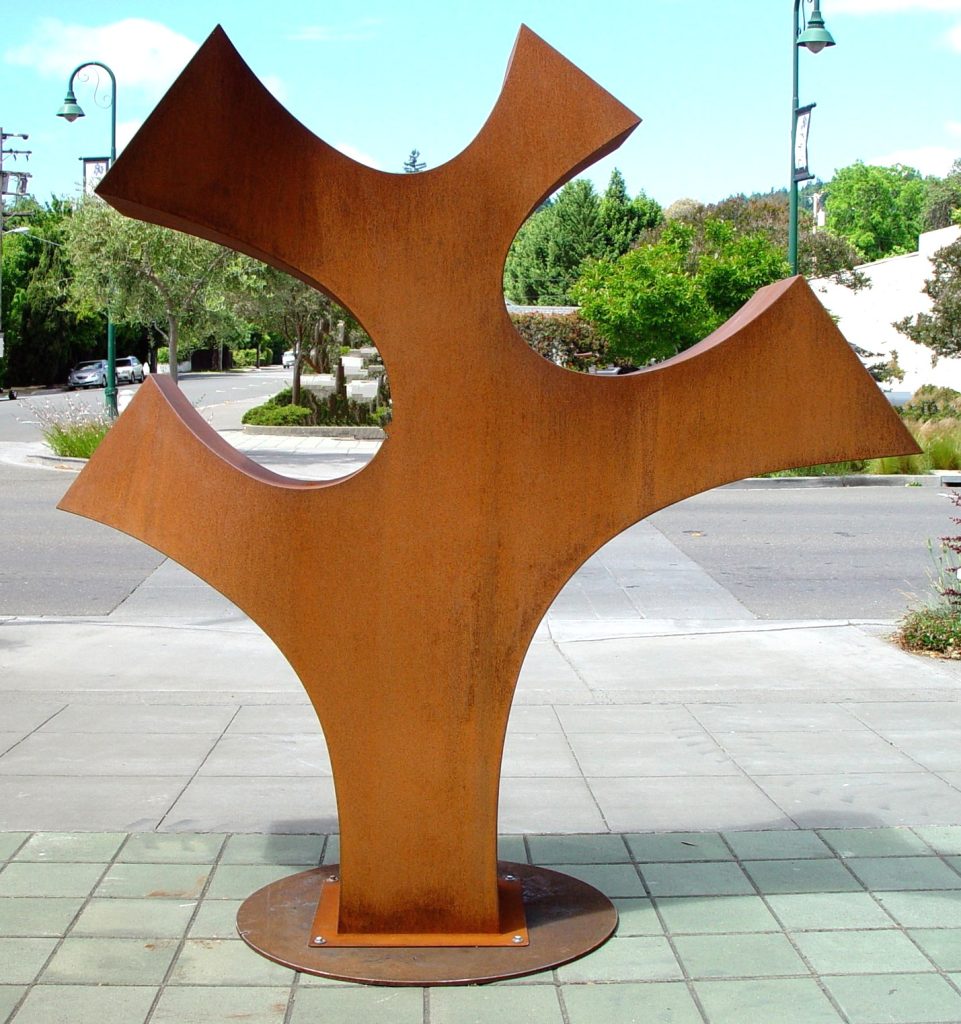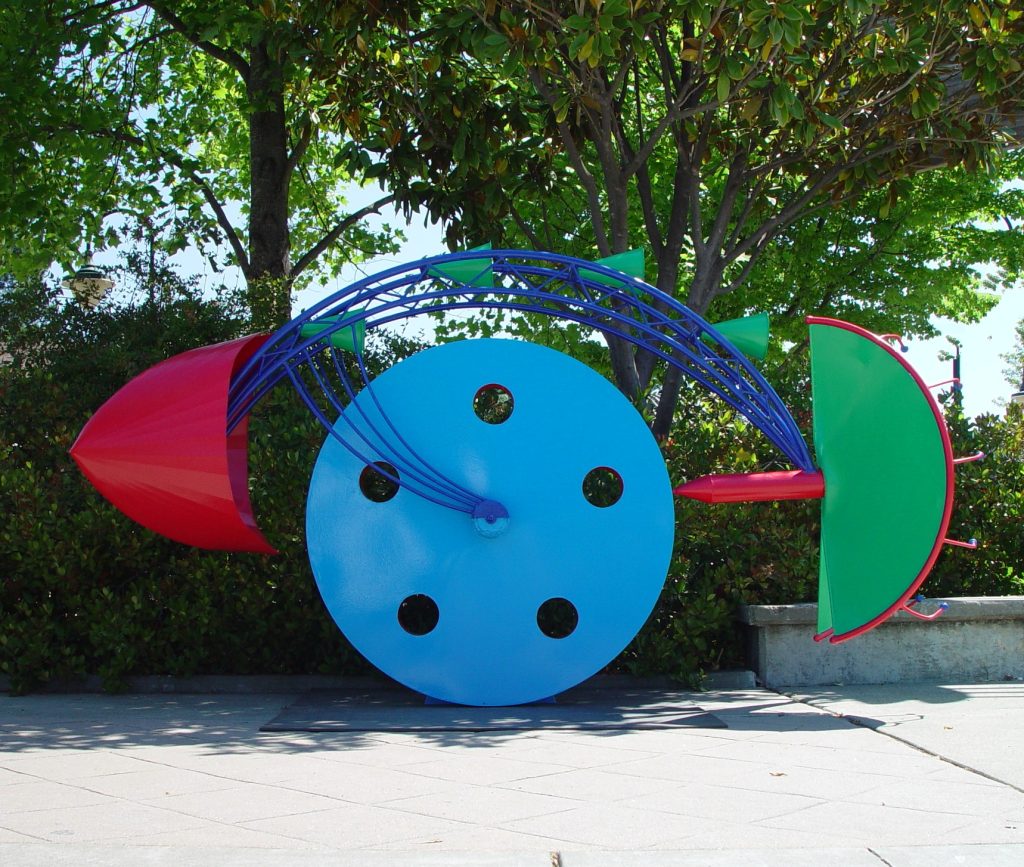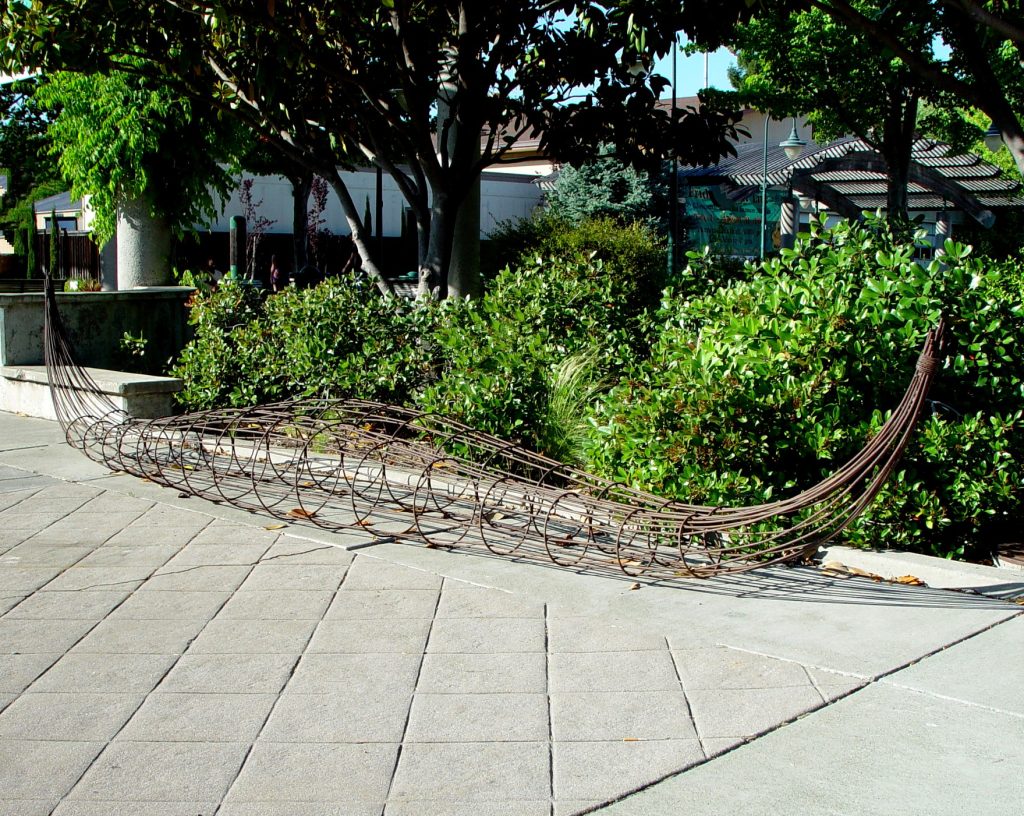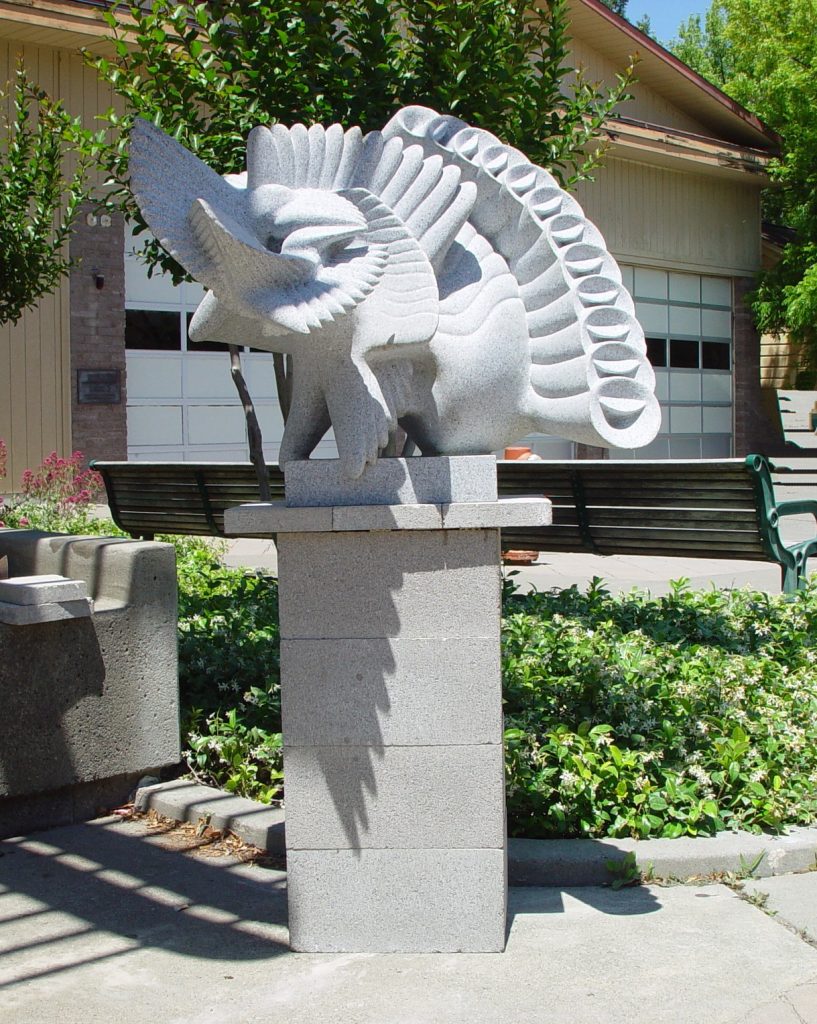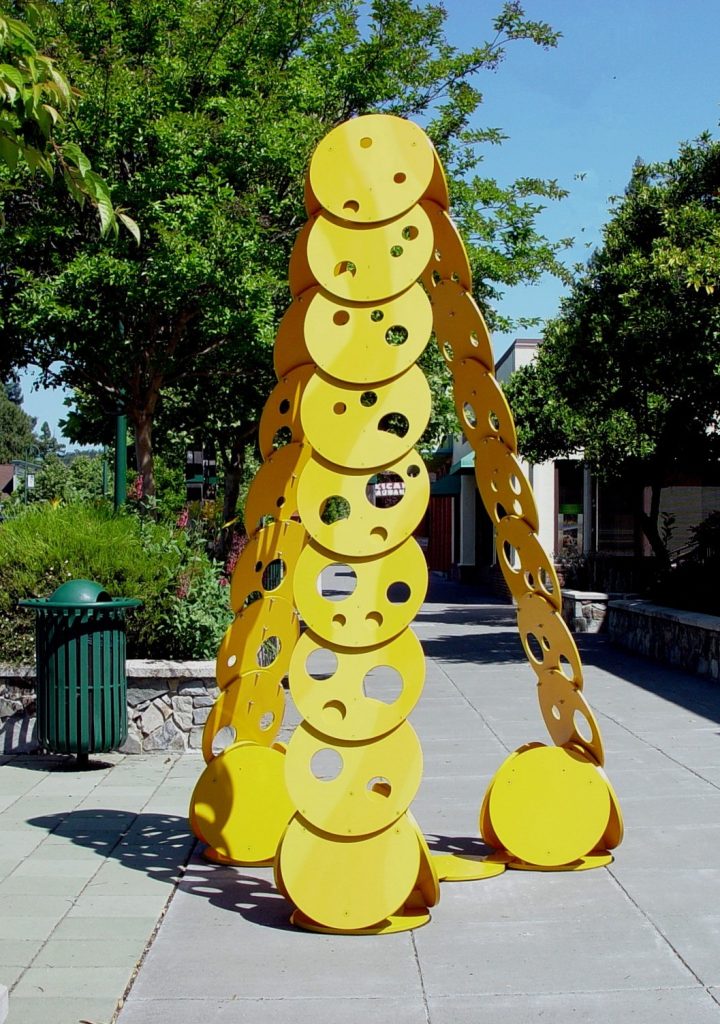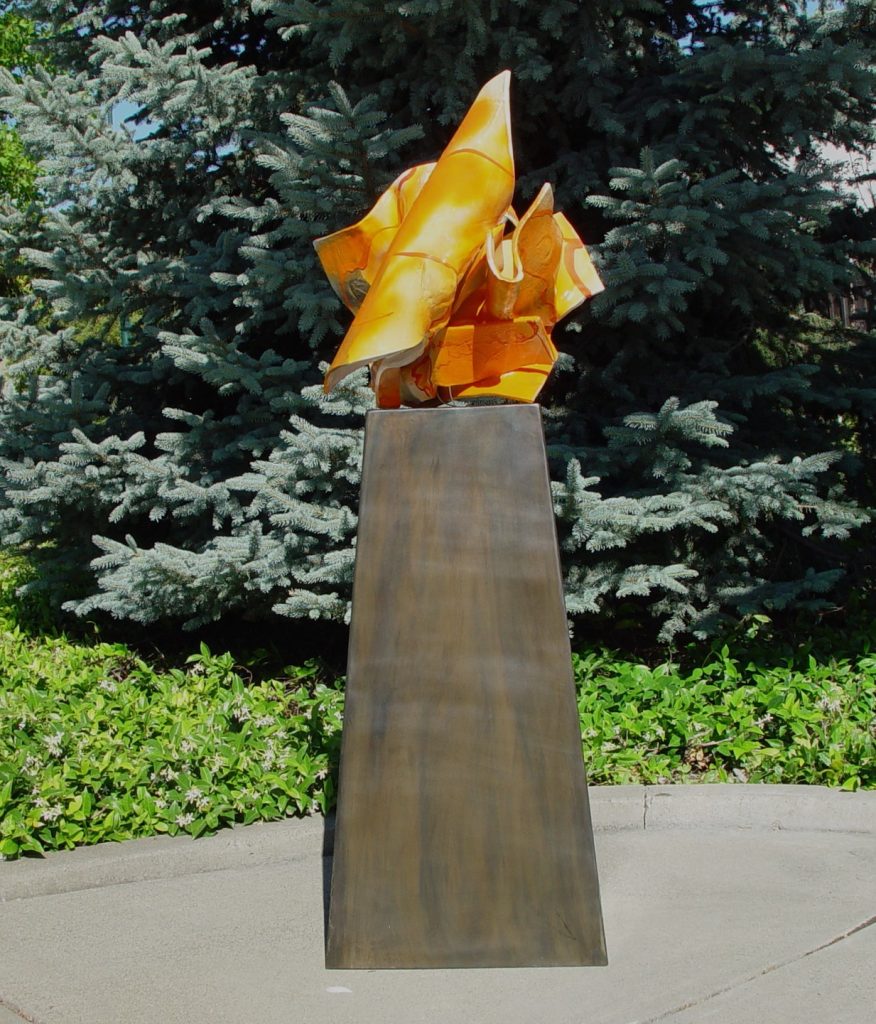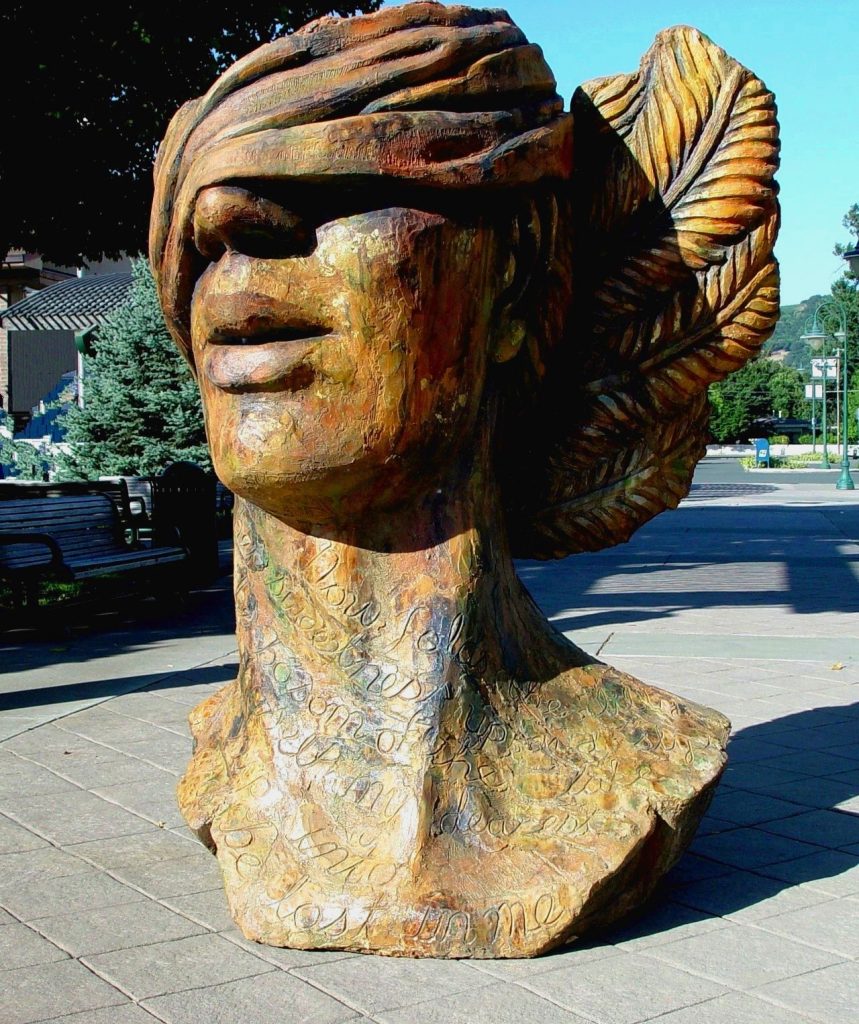- Al Voigt Best of Show: Albert Dicruttalo, “Offshoot”
- Honorable Mention: David Mudgett, “RELIC”
- Honorable Mention: Richard Starks, “CT-58”
Congratulations to those receiving awards, and to all of the artists who are featured in this juried Exhibit:
Albert Dicruttalo
Offshoot
5′ x 7′ x 5′ Steel
Part of a series inspired by bi-lobe succulent plants. These plants are characterized by one of more pairs of bulbous leaves opposite to each other that produce new leaf pairs from the inside. Dicruttalo was drawn to represent the plants by their simple elegance, symmetry and efficiency. “In finishing the piece in burnished and waxed iron oxide”, says Dicruttalo, “I hope to present a formal work that is honest in its finish, true to its media and connected to nature.”
David Mudgett
Relic
5′ x 5′ x 5′
272 pieces of formed rebar held together with 455 welds
Mudgett works mainly in steel, specializing in large abstract outdoor pieces that blend well with nature. His sculpture “DRAIN” won Best of Show in 2006, and his 2011 entry, “GRASP” is on loan across the Boulevard. “I was first drawn to metal by my grandfather, the pipe fitter”, says Mudgett. “Following in his footsteps,
I was fortunate to serve my apprenticeship in a massive pipe fabrication shop, and spent years as a pipe fitter. The ease at which large pieces of metal could be formed into limitless objects fascinated me, and the metal soon became an affliction. These years of metal fabrication gave me a firm grasp of steel. I unfortunately found the conventional uses littered with boundaries.” Mudgett explains how he became a sculptor: “Urged to apply my metalworking skills to art, I produced my first sculpture. This new found form of expression was exhilarating. I had stumbled upon the creative freedom that I was searching for.”
Richard Starks
CT-58
88″ x 84″ x 39″
After receiving his degree in Industrial Studies with an Art minor from San Jose State University in 1968, Starks taught Industrial Studies in San Jose high schools for 30 years. He returned to SJSU after retiring from teaching, and is presently taking sculpture and public art classes while creating sculpture full time. In 1998 he began creating larger welded metal sculptures, most of which originate from shapes he imagines, as is the case with “CT-58”.
“In my sketchbook I began with a series of lines which eventually turned into a pictorial or 3-dimensional sketch,” says Starks of his process. “From this sketch I began my process of forming a three dimensional form in steel.” Using 12 gauge cor-ten sheet steel, Starks cuts out, bends, tacks and then welds the entire form, after which he grinds and blends every weld and edge. “My goal was to create a form that looked as if it had been made from a solid chunk of steel.” The finish is natural rust which takes several years to reach a final dark brown color.
Stan Huncilman
Hydromaticus
58″ x 108″ x 32″
Brightly painted steel
Huncilman welds steel together with organic elements to create objects that are humorous, mythological, and always enigmatic. Readers may recall last year’s Honorable Mention winning entry, “La Menyna,”in the center of the Boulevard, or the previous year’s entry, “Alchemist’s Dilemma” in front of city hall.
Huncilman’s bright colors and intriguing forms enchant viewers, sparking sentimental memories and inviting approach. “I combine a child-like playfulness with primitivism,” says Huncilman. Upon contemplation, however, a viewer may find a wonderland of intriguing forms and convoluted messages, rooted in religion, folk art, nineteenth century industrialism or Greek mythology.
Huncilman has been compared to an alchemist – not in the sense that he transmutes physical material – but in the sense that his work transmutes the observer’s mind toward recognition of objects that are common in our everyday lives. This challenge to look at commonplace items differently is described as “An alchemy for the soul …the phenomenon of great art.”
Bill Rodgers
Reed Boat
3′ x 16′ x 3′
Steel, screen
“Reed Boat”, previously displayed in Bronx, NY and Santa Fe, NM, sails into the Cloverdale plaza courtesy of sculptor Bill Rogers. “Reed Boat” renders the ancient form of a reed boat in steel. Rogers explains his fascination with the design: “The design, thousands of years old, is still a common sight on the waterways of both Egypt and Peru. The architecture of those reed boats is dictated by the local materials. Papyrus reeds are cut from groves and bundled into logs. Those elements are then lashed together to create a buoyant craft. It’s remarkable that two cultures — one on Lake Titicaca, landlocked and separated by two oceans from the other on the River Nile — arrived at the same design. Was the idea sailed across the seas, as Thor Hyerdahl famously demonstrated, or was the reed boat form the obvious solution to an engineering problem? Probably both elements helped the two cultures converge.”
Rogers enjoys capturing objects in bronze, aluminum or steel that have long since succumbed to the elements. He considers them, “Objects forgotten until found, lured into beauty by their own mundane decay.” His steel “Reed Boat” weighs less than 100 pounds, lighter that the natural fiber version, and would displace about 500 pounds of water if wrapped in a skin. That means it could float a large person and a hundred pounds of gear, and have plenty of buoyancy to spare.
Jason Butler
Untitled Steel Sculpture
7′ x 4′ x 4′
“Placing my sculptures in public places is exciting to me, “says Jason Butler, “on campuses, plazas and in parks where they may be seen by all.” This is Butler’s first piece to be exhibited in Cloverdale. The work is untitled and is constructed of oxidized steel. Butler says of his preference for working in steel, “I am attracted to the common, strong, historic and industrial nature of steel. I aim to transform off-the-shelf, stock shapes toward a higher level of creative expression. I enjoy the challenging and very physical process of manipulating steel. I deliberately choose a very physical practice, in contrast to contemporary conceptual, virtual and digitally based trends.”
In his work, Butler seeks dramatic juxtaposition by using curving, organic lines in composition with straight, flat and angular geometries. “For 10 years I have worked around the relationship between straight and curve,” states Butler. “These lines are charged with qualities representative of my personal experience. ” His associations of straight: hard, dutiful, direct, expected, banal, asphalt, dry and dull and of curve: soft, fun, graceful, surprise, refreshing, moss, moist and bright. These are interesting springboards for thought as you view “Untitled” in the plaza.
Robert M. Smith
Paradise Bird Burlesque
2′ x 3′ x 2′
Granite
Following his Best of Show award in 2010 for “Chautauquantumandala”, Robert Michael Smith returns to Cloverdale with “Paradise Bird Burlesque.” The piece was produced through repeatedly lofted forms scaled and rotated around a central axis by CAD program then enlarged and carved in granite. Exhibiting both floral and avian attributes, the title borrows from Bird of paradise, which is the name for both a tropical flower and bird. Burlesque was included in the title to reference implied movements of an erotic mating dance performed by the flower/bird spirit.
Smith’s forms, though fantastical, are inspired by nature, as he explains: “Art is alchemy. Alchemy is the magic, observation, process and ritual of life. My sculptures, both virtual and actual, are conversations regarding the archetypal forms that are reflections of the basic structures of nature. These alien forms are intended as meditative objects to open contemplative exploration to the deepest regions of the human psyche for creative development within the landscape of the imagination.”
Eric Furman and Ananda Oliveri
Solar Observatory
8′ 8″ x 5′ x 5′
Recycled metal scraps
The Cloverdale Arts Alliance welcomes Eric Furman’s work back to the plaza, this year in the form of a skeletal tetrahedron — a four sided polyhedron made from equilateral triangles — called “Solar Observatory.” The piece is made from over 99% recycled metal scraps — only the stainless steel fastenings and paint are new materials. The 40 aluminum discs are byproducts from machining very large adjustable ball bearings. Furman collaborated with a colleague, Ananda Oliveri, on the piece, completed earlier this year.
“The motivation to create ‘Solar Observatory’ came from both my concern with the great amount of waste material our society produces, and my fascination with geometric forms,” says Furman. “Although much of the metal scrap we generate is melted down and alloyed into new stock, I look for ways to conserve energy by reusing metal scrap in its raw form.” Furman repurposes the metal used in his work, building meaning by forging and joining metals as a response to what he terms our increasingly fragmented society.
Patricia Vader
Kinetic Sculpture “Flying Fish”
12′ x 6.5′
Bicycle parts
Patricia Vader had a lot of fun with bicycle parts constructing her wind-driven kinetic sculpture, “Flying Fish”. The main body of the fish is a functional wheel mounted on a bicycle fork, which allows the fish to function as a freely rotating weather vane while also bobbing up and down about its wheel axis. “I’ve always liked bicycle wheels, and I wanted to use them somehow. I just had to figure out to make them spin in the wind, “says Vader. “Most of my pieces are whimsical larger-than-life representations of animals and plants. A frequent comment is that they bring joy to the viewer.”
Brian Wilson
Pop Rocket
3′ x 2.5′ – Ceramic
Healdsburg artist Brian Wilson’s first entry into the Cloverdale Sculpture Exhibit is “Pop Rocket”, visible in the window of the First Street Gallery. This bright orange piece is a low fire contemporary ceramic sculpture. Wilson loves the unique and vibrant Italian colors of low fire glazes.
Peter Crompton
Psyche Sings
79″ x 59″ x 46″
“Psyche Sings”, the large face of a goddess, was the winner of the People’s Choice Award at the opening of the 2012 Annual Sculpture Exhibit. Peter Crompton crafted the piece of gold leaf and fortified reinforced concrete over structural foam. “Throughout my work,” Crompton says, “I have explored the symbolic possibilities of the human figure, particularly in my sculpture. Because they are often over-life-size, they have a theatrical impact that I find appealing.” Crompton also designs stage scenery throughout the bay area, and has taught college courses in Design & Scenic Arts and Design & Stagecraft.
Crompton explains the myth behind the piece, “Pysche was blindfolded so that she would not realize that her lover, Eros, was a god. Unable to resist temptation, she looked at him, thus ending the relationship. After she journeyed to the underworld Eros reclaimed and apotheosized her. Her name has come to be synonymous with ‘soul’.” Crompton explains, “The poem inscribed on her neck is the last verse of a Tennyson opus about sex, death and surrender. These are the themes of this piece.”



